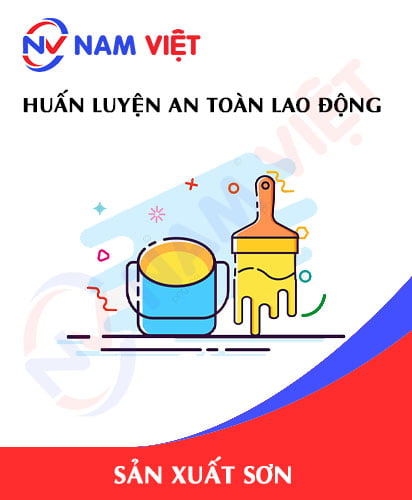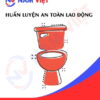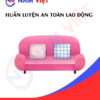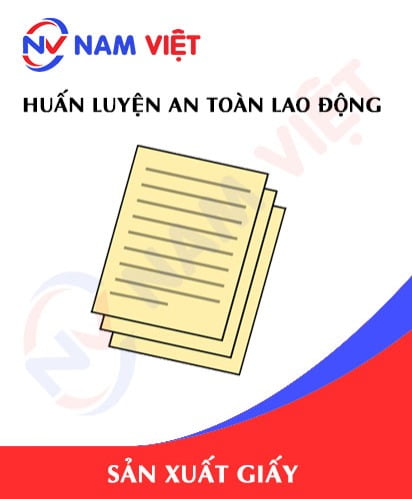Occupational Safety Training in Paint Manufacturing Factory
99,000 ₫
Note: The above price is calculated for one person, the price may fluctuate depending on the number of trainees participating in the course and the movement of the market. For more accurate pricing support, please refer to the quotation table or contact our consulting staff directly.
Occupational safety is an important issue in paint manufacturing factories and needs to be addressed promptly to ensure the health and safety of workers and enhance the reputation of enterprises. The Occupational Safety Training course is one of the effective solutions to raise awareness about preventing occupational accidents for workers when participating in paint manufacturing.
Table of Contents
Toggle1. Overview of paint
a. What is paint?
- Paint is a liquid substance used to cover the surface of materials to protect them from corrosion and environmental influences, and for decoration. Paint is made from a mixture of chemical compounds dispersed in a solvent. The components of paint include color particles, binders, and protective compounds. Paint is widely used in construction, automobile manufacturing, machinery, and household products for surface decoration and protection. Common types of paint include oil paint, water-based paint, acrylic paint, and epoxy paint.
- Paint is a mixture of chemical compounds dispersed in an aqueous solvent. It is widely used in the industrial and construction fields to protect and decorate the surfaces of materials such as wood, metal, concrete, etc.
- The paint manufacturing industry is a developing industry in Vietnam’s economy. Businesses in the industry have achieved many achievements and developed strongly in recent years. According to the Global Paint Market Report by the market research company Zion Market Research, in 2020, Vietnam’s paint market is predicted to reach a value of about 1.05 billion USD by 2026, with an estimated annual growth rate of about 6.5%.

b. Types of paint manufacturing machinery
The types of paint manufacturing machinery and equipment commonly used in the paint manufacturing process include:
- Paint mixer: this is a type of machine used to mix the paint components together such as color particles, solvents, film-forming agents, thickeners…
- Paint sprayer: this is a type of machine used to spray paint onto the surface of materials. There are many different types of paint sprayers such as compressed air sprayers, airless sprayers, electric sprayers…
- Paint cutter: this is a type of machine used to cut off peeled or damaged paint layers on the surface of materials.
- Paint press: this is a type of machine used to press and inject paint onto the surface of materials. The paint press can be a static press or a dynamic press.
- Paint dryer: this is a type of machine used to dry the paint layer on the surface of materials with high temperatures or infrared radiation.
- Viscometer: this is a type of machine used to measure the viscosity of paint, helping to check and adjust the quality of the paint.
All types of paint manufacturing machinery and equipment are designed to meet the strict requirements for quality and efficiency in paint manufacturing.

c. Typical paint manufacturing businesses in Vietnam
In Vietnam, there are many paint manufacturing businesses, some of which are typical as follows:
- Jotun Paints Vietnam: is one of the leading paint manufacturing companies in Vietnam, established in 1994. This company provides high-quality paint products, with diverse colors and applications for many fields such as construction, marine, oil and gas, shipbuilding…
- Kova Paint Group: established in 1995, Kova Paint Group is one of the leading businesses in the paint manufacturing industry in Vietnam. The company provides high-quality paint products, with diverse colors and application features.
- Toa Paint Vietnam: is a company belonging to Toa Paint Group, established in 2011. Toa Paint Vietnam provides high-quality paint products, fully meeting the requirements for color, application features, and environmental protection.
- Dulux Vietnam: owned by AkzoNobel, one of the world’s leading companies in the paint industry. Dulux Vietnam provides high-end paint products, with diverse colors and applications for many fields, from construction to interior.
- 4 Oranges: is a Vietnamese business established in 2007, specializing in manufacturing high-quality paint with advanced technology and a team of experienced experts. The company provides high-quality paint products that are safe for health and environmentally friendly.
d. Specific jobs in a paint manufacturing factory
Group 1
- Executive director, deputy executive director, department head in a paint manufacturing factory.
Group 2
- Safety officer: manages safety in the factory, designs safety procedures, supervises and urges employees to comply with safe working procedures.
Group 3
- Preparing raw materials: Raw materials such as particles, additives, solvents, and binders are used to create paint. Workers in the factory must ensure that the raw materials put into manufacturing meet the necessary quality standards.
- Mixing paint: The raw materials are put into a mixer to create a homogeneous mixture. This mixing process is very important, as it affects the quality of the final product.
- Quality control: Paint samples are taken to check viscosity, gloss, and hardness. Workers in the factory must ensure that these samples meet quality standards before the paint is put into manufacturing.
- Paint manufacturing: After quality control, paint is manufactured in paint manufacturing machines. The paint is manufactured in liquid or powder form depending on the type of paint.
- Paint packaging: After the paint is manufactured, it is packaged into bags and barrels to prepare for transportation and sales.
- Machine cleaning and maintenance: Machinery and equipment in a paint manufacturing factory must be regularly cleaned and maintained to ensure product quality and employee safety.
- Waste management: A paint manufacturing factory needs to manage waste properly to ensure no negative impact on the environment. Waste such as dust, chemical fumes, and wastewater must be treated and transported in a safe and proper manner.
Group 4
- Jobs in the office, serving, sales, marketing.
- Manufacturing management, quality management, human resource management, material management, financial accounting management.
- Research and development of new products, designing product packaging models.

2. Overview of the occupational safety training course for paint manufacturing
In this article, we focus on issues revolving around Group 3, because Group 3 is the group directly involved in the manufacturing process, bearing the highest risk of occupational accidents. Refer to other groups here
a. What is Group 3 occupational safety training?
- Occupational safety training for Group 3 consists of sessions that equip workers with awareness of how to prevent occupational accidents.
- The occupational safety training course will help workers recognize and prevent dangers, and limit the risks of occupational accidents during work.
REGISTER FOR OCCUPATIONAL SAFETY TRAINING SERVICE
b. Training duration
Initial safety training duration
- The total training duration is at least 24 hours, including test time.
- 8 hours of theoretical study on the policy and legal system for occupational safety and health
- 8 hours of theoretical study on basic knowledge of occupational safety and health
- 4 hours of theoretical study on specialized training content
- 2 hours of practical study on specialized training content
- 2 hours of theoretical test at the end of the training course
The safety training center will distribute the time into several training sessions depending on the time arrangement for employees. But typically, there will be 6 training sessions, and the course will last for 3 days, provided that the manufacturing business can arrange continuous study time.
Periodic safety training duration
- Before the occupational safety card expires, if the worker wants to renew it, they must undergo a periodic occupational safety training course, with the periodic safety training duration being at least 50% of the initial safety training duration.
Explanation: the total periodic occupational safety training duration is at least 12 hours, including test time. After completing the periodic training course and passing the test, the worker will be reissued or have their occupational safety card renewed.
c. Content of the training course
| No. | TRAINING CONTENT | TRAINING DURATION (HOURS) | |||
| Total | Of which | ||||
| Theory | Practice | Test | |||
| I | Policy and legal system for occupational safety and health | 8 | 8 | 0 | 0 |
| 1 | Overview of the system of legal documents on occupational safety and health. | 6 | 6 | ||
| 2 | System of technical standards and regulations on occupational safety and health. | 1 | 1 | ||
| 3 | Specific regulations of state management agencies on occupational safety and health when building new, expanding, or renovating works, facilities for manufacturing, using, preserving, storing, and inspecting machines, equipment, materials, and substances with strict requirements for occupational safety and health. | 1 | 1 | ||
| II | Basic knowledge of occupational safety and health | 8 | 8 | 0 | 0 |
| 1 | Basic knowledge of dangerous and harmful factors at the workplace. | 4 | 4 | ||
| 2 | Methods for improving working conditions. | 1 | 1 | ||
| 3 | Safety culture in manufacturing and business. | 1 | 1 | ||
| 4 | Rights and obligations of employers and employees; policies and regimes on occupational safety and health for employees; functions and duties of the network of occupational safety and health officers. | 1 | 1 | ||
| 5 | Occupational safety and health regulations, signs, occupational safety and health guidance signs, and the use of safety equipment, personal protective equipment; professional skills, first aid for occupational accidents, and prevention of occupational diseases. | 1 | 1 | ||
| III | Specialized training content | 6 | 4 | 2 | 0 |
| General knowledge about types of machines, equipment, substances that generate dangerous and harmful factors; analysis, assessment, management of risks related to occupational safety and health, safe working procedures with machines, equipment, and substances with strict requirements for occupational safety and health. | 6 | 4 | 2 | ||
| IV | Test on occupational safety training content at the end of the course | 2 | 2 | 0 | 0 |
| Total | 24 | 22 | 2 | ||
See more training content for 6 groups
d. Occupational safety card
After completing the occupational safety training course and passing the test, the worker will be issued an occupational safety card (commonly called an occupational safety certificate for Group 3).
The Group 3 safety card will clearly show information such as: full name, date of birth, specific job and working environment. It also includes the training duration, a red seal, and a signature confirming the completion of the training course.
According to the regulations on issuing safety cards specified in Clause 2 of Article 24 of Decree 44/2016/ND-CP, there are two cases:
- In the case where the employer and the employee have a labor contract, the employer must sign, seal, and affix a seal on the joint of the safety card for the trained person in Group 3 after they have undergone the training course from an occupational safety training unit and passed the test.
- In the case of freelance or seasonal workers who do not have a labor contract, the training unit must sign, seal, and affix a seal on the joint of the safety card for the worker after they have undergone the training course from an occupational safety training unit and passed the test.

3. Identifying dangers affecting workers when manufacturing paint
Paint manufacturing can pose many health hazards to workers, including:
- Chemicals used in paint such as organic compounds, heavy metal compounds, reactive chemicals, fillers, and solvents can cause health problems such as headaches, dizziness, neck pain, stomach pain, shortness of breath, pneumonia, nerve damage, and cancer in cases of continuous and long-term exposure.
- The use of furnaces to heat paint during the manufacturing process can also create health hazards for workers.
- Paint manufacturing often involves the use of machinery and equipment that can create loud noise, affecting the hearing of workers.
- Equipment used in paint manufacturing such as pressure vessels and spray guns can create high atmospheric pressure, leading to accidents and injuries.
- Paint manufacturing can also be related to many other agents such as dust, smoke, ultraviolet rays, and electricity, causing health problems for workers.
4. Common types of occupational accidents for workers when manufacturing paint
Common occupational accidents that occur during the paint manufacturing process include:
- Exposure to toxic chemicals: When manufacturing paint, workers must be exposed to toxic chemicals such as xylene, toluene, formaldehyde, and acetone. Long-term exposure to these chemicals can cause health problems such as dizziness, headaches, shortness of breath, and can sometimes cause damage to the heart, liver, and kidneys.
- Accidents when using equipment: Workers in a paint manufacturing factory must use equipment such as paint sprayers, mixers, dryers, and cutters. The use of this equipment can cause accidents such as cuts, burns from contact with high temperatures, and accidents related to machinery.
- Fire and explosion risk: Paint often contains flammable chemicals and conductive substances, so during the manufacturing and use of paint, there is a risk of fire and explosion.
- Dust effects: The manufacturing and spraying of paint can create dust, which is dangerous for workers to inhale. This can lead to health problems such as coughing, wheezing, shortness of breath, and allergies.
- Accidents during transportation and storage: In addition to the risks during the paint manufacturing process, transportation and storage can also cause accidents such as collisions, chemical leaks, and explosions.
5. Safety measures when participating in paint manufacturing
To ensure the safety of workers when participating in paint manufacturing, the following safety measures should be applied:
- Ensure hygiene and occupational safety: Paint manufacturing factories need to ensure hygiene and occupational safety by providing personal protective equipment, instructing on how to use them properly, and periodically checking and maintaining this equipment.
- Use personal protective equipment: Paint manufacturing factories need to provide adequate personal protective equipment for workers such as safety glasses, gloves, masks, and protective clothing.
- Train employees on occupational safety: Employees participating in paint manufacturing need to be trained on occupational safety, procedures, and necessary safety measures during the paint manufacturing process.
- Ensure environmental hygiene: Paint manufacturing factories need to ensure environmental hygiene by using environmentally friendly paint manufacturing technologies, controlling, and reducing the amount of emissions, waste, and wastewater.
- Use safe paint manufacturing equipment and technology: Paint manufacturing factories need to use safe paint manufacturing equipment and technology, ensuring that raw materials and chemicals are stored and used correctly, and minimizing risks for workers during the paint manufacturing process.
- Control product quality: Paint manufacturing factories need to control product quality to ensure that the products meet safety, quality, and environmental requirements.
- Periodically organize labor environment monitoring in factories and enterprises, collect and analyze harmful factors to employees, thereby adjusting to reduce the level of harm to prevent occupational diseases for them.

6. Benefits of occupational safety training in paint manufacturing
An Toan Nam Viet provides businesses with the following great benefits after completing occupational safety training courses as stipulated in Decree 44/2016/ND – CP on occupational safety and health work, for companies, factories, and businesses.
- Employees can recognize potential risks of occupational accidents and thus have preventive measures to avoid occupational accidents.
- Your business can establish risk prevention measures in the manufacturing, operation, and maintenance processes.
- Reduce costs when there is a risk of occupational safety loss.
- Uninterrupted manufacturing will help increase labor productivity and product quality.
- Comply with occupational safety laws, avoiding legal risks.
- Create credibility and professionalism in all aspects, thereby elevating the brand for your business.
The training courses of Nam Viet are a solution to prevent and combat external factors affecting individuals so that they can avoid dangers that can lead to injury or, more seriously, death.
REGISTER FOR OCCUPATIONAL SAFETY TRAINING SERVICE
7. Customer feedback after completing the occupational safety training course for paint manufacturing
An Toan Nam Viet has many years of experience in the mission of accompanying many businesses in Vietnam in general and in the southern provinces in particular. And that responsibility is something very valuable to Nam Viet, which is why the Occupational Safety Training work of Nam Viet is increasingly focused on becoming more professional. The motivation for An Toan Nam Viet to grow strongly to the present comes from the positive feedback and suggestions from businesses. Below is the feedback from our partners we have served.
Bac Nam E&C Construction Investment Joint Stock Company
“The first time I used the service at An Toan Nam Viet, I was very surprised by the enthusiastic 24/7 support of the team of consultants. The class organization was very quick and convenient for our company, thank you very much for Nam Viet’s service!”
Hoa Dat Construction and Trading Joint Stock Company
“Nam Viet’s service has helped us a lot in simplifying occupational safety and the task of completing safety records for our work process. The team of consultants is enthusiastic and responds promptly to our questions. 5 stars for Nam Viet”
See more customer interviews after using the service of An Toan Nam Viet
8. Occupational Safety Training Capability of An Toan Nam Viet
An Toan Nam Viet is a reputable and quality occupational safety training center in Vietnam today. With occupational safety training sessions continuously taking place at factories, plants or construction sites across the country (63 provinces and cities in Vietnam).
REGISTER FOR OCCUPATIONAL SAFETY TRAINING SERVICE
License for occupational safety training
- An Toan Nam Viet has been inspected and certified by the Department of Occupational Safety of the Ministry of Labor – Invalids and Social Affairs as being qualified to conduct occupational safety and health training. This further strengthens our capability in occupational safety training.

Documents and lectures
- Before occupational safety training materials are introduced into occupational safety training courses, they are reviewed and approved to ensure that the lectures are accurate in terms of knowledge and effective when applied.
- The teaching method of the instructors is synchronized according to the teaching standard of An Toan Nam Viet, a method that experts in occupational safety and health training have researched and distilled during the teaching process to bring the highest knowledge acquisition efficiency for students.
Facilities
- Controlling factors in the classroom that affect the training process will increase teaching productivity and the effectiveness of knowledge acquisition for students.
- Our facilities to support the training course always arrange spacious classrooms that meet standards for area, lighting, training equipment, etc.
9. Reputable and quality safety training center nationwide
At An Toan Nam Viet, we always prioritize our professional dedication to occupational safety training. For us, imparting self-protection knowledge to workers so they have a safe foundation on their livelihood path is a contribution to nation-building.
To ensure effective training, we prepare carefully and meticulously even the smallest details. From preparing tools, equipment, and teaching aids to textbooks, documents, sound, and lighting.
Our occupational safety training instructors are experts with many years of experience in the field. They even have research projects on identifying dangers in all professions and how to prevent them.
The instructors’ lectures are distilled from practical experience and conveyed in a vivid and easy-to-understand way for the workers. These factors help workers feel comfortable during their study time and absorb our teaching knowledge well. Of course, the knowledge conveyed always adheres closely to Decree 44/2016/ND-CP.
From there, they grasp many measures to prevent danger and protect themselves. They also apply them in the most suitable way in their actual work.
Our safety training center is proud to be a reputable and professional provider of occupational safety training services with the following advantages:
- Competitive training costs but training quality is still ensured.
- Flexible training schedule based on the manufacturing situation of the company and business.
- Quick and legally compliant procedures for issuing occupational safety training certificates.
- Training instructors are those with many years of experience in the profession.
- The classroom is controlled for factors affecting the training process, increasing teaching productivity and the effectiveness of knowledge acquisition for students.
- The lectures are compiled to be suitable for occupational safety work at businesses.
- An Toan Nam Viet works dedicatedly and professionally to support customers accurately and as quickly as possible.

10. Refer to more occupational safety training materials for paint manufacturing
- Occupational safety training documents for paint manufacturing
- Set of occupational safety training documents
- Set of occupational safety training test questions
- Multiple-choice test for occupational safety training in paint manufacturing
- Slides of the lecture on occupational safety training in paint manufacturing
1 review for Occupational Safety Training in Paint Manufacturing Factory
No comments yet















namchinh.haiphong341
Dịch vụ huấn luyện an toàn lao động rất tốt nhé, giảng viên dạy rất sinh động dễ hiểu!